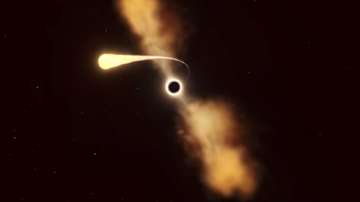Black holes, a product of our Universe, are always fascinating to discover as they hold answers to a lot of unaswered questions astronomers have been waiting to know. As we all know that there is a lot that is happening within our Universe, be it events taking place in the cosmic world or something new about black holes. In one such event, the European Southern Observatory (ESO) has shown the death of a star which got sucked by a black hole.
The European Southern Observatory (ESO) on its YouTube page shared a video showing "Death by spaghettification: artistic animation of star being sucked in by a black hole." This animation depicts a star experiencing spaghettification as it’s sucked in by a supermassive black hole during a 'tidal disruption event'.
According to European Southern Observatory (ESO), in a new study, done with the help of ESO’s Very Large Telescope and ESO's New Technology Telescope, a team of astronomers found that when a black hole devours a star, it can launch a powerful blast of material outwards.
Earlier in September, a team of international scientists, led by those from India, found a distinctive signature of cosmic X-rays to identify the boundary around black holes, which "unmistakably separate them" from other objects in the cosmos such as neutron stars that are comparable in mass and size.
According to the astrophysicists, including Sudip Bhattacharyya from the Tata Institute of Fundamental Research (TIFR) in Mumbai, the current discovery is by far the strongest steady signature of the smaller, but more extreme stellar-mass black holes to date, from the cosmic X-rays observed with a satellite.
Although black holes does not have a surface, it is confined within an invisible boundary, called an event horizon, from within which nothing, not even light, can escape, the scientists said.
While definitive proof of the existence of such objects is a holy grail of modern physics and astronomy, they said only one supermassive black hole with the mass more than six billion times the mass of the Sun has so far been imaged using the surrounding radiation in radio wavelengths.

